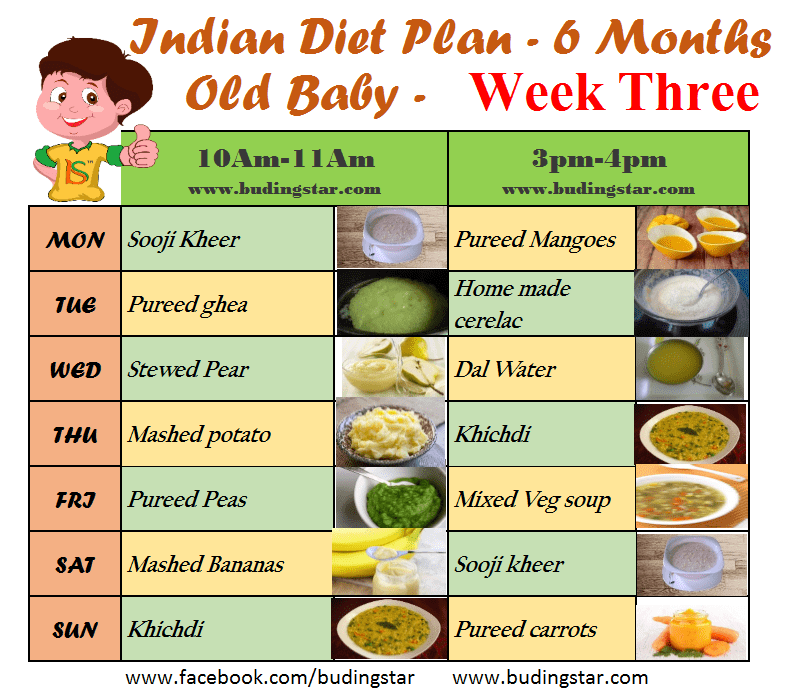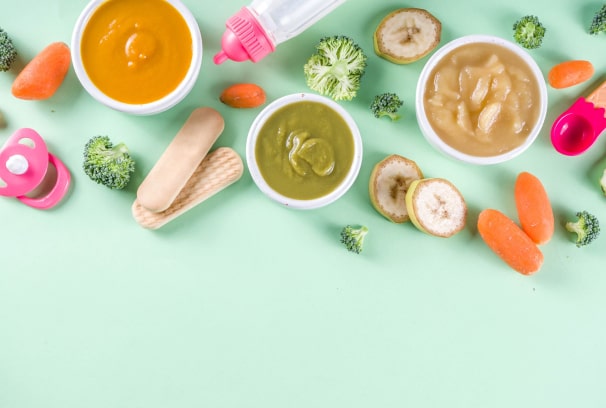8 month baby food recipes in hindi
जानें क्या है 8 महीने के शिशु का हफ्तेभर का डाइट चार्ट, कैसा होना चाहिए खाना
शिशु को 6 महीने के बाद से ठोस आहार लेना शुरू करता है और फिर हर महीने के साथ बच्चे का पाचन बदलता रहता है जिसके हिसाब से उसके आहार में भी बदलाव करते रहना होता है।8 महीने के शिशु के खाने में आप कई पौष्टिक चीजों को शामिल कर सकते हैं। यहां हम आपको 8 महीने के बच्चे के लिए डाइट चार्ट बता रहे हैं।
8 महीने के बच्चे को क्या खिलाएं
शिशु को सोमवार की सुबह करीब 6 से 7 बजे ब्रेस्ट मिल्क या फार्मूला फीड दें। इसके बाद नाश्ते के समय शिशु को इडली में थोड़ा सा घी या मक्खन मिलाकर खिलाएं। मक्खन घर का निकला हुआ हो तो ज्यादा बेहतर है।
दोपहर के खाने से पहले यानि 11 से 12 बजे के करीब शिशु को ब्रेस्ट मिल्क या फार्मूला फीड दें, दोपहर का खाना करीब 2 बजे कराएं जिसमें आप शिशु को चावल और गाजर का दलिया खिलाएं।
शाम 5 से 6 बजे बच्चे को मां का दूध या फार्मूला फीड दें। आप इसकी जगह किसी फल को भी मैश कर के दे सकती हैं। वहीं रात के खाने में सेब की प्यूरी बनाकर खिलाएं।
यह भी पढ़े : 8 महीने के शिशु के लिए नारियल और चावल से बनाएं बेबी फूड
मंगलवार का खाना
मंगलवार की शुरुआत भी सोमवार की तरह ही करें लेकिन आप दोपहर के खाने में शिशु को गाजर और चुकंदर का सूप पिलाएं साथ ही रात के खाने में रागी और गेहूं का बना हलवा खिलाएं इससे शिशु की हड्डियां मजबूत होंगी।
बुधवार के दिन क्या खिलाएं
बुधवार को सुबह ब्रेस्ट मिल्क पिलाएं और फिर थोड़ी देर बाद इडली और घी साथ मिला कर खिलाएं। दोपहर के खाने से पहले मां का दूध या फार्मूला फीड दें। आप दोपहर के खाने में इडली और घी के साथ साथ कोई फल भी मैश कर के खिला सकती हैं। शाम को स्तनपान करवाएं और फिर रात के खाने में दाल में भीगी रोटी मींड कर खिलाएं।
यह भी पढ़े : 7 महीने के बच्चे की मोटाई और लंबाई बढ़ाने के लिए मिनटों में बनाएं बेबी फूड, हाजमा होगा दुरुस्त
बृहस्पतिवार की डाइट
दिन की शुरुआत स्तनपान से करें। आप शिशु को नाश्ते में करीब 9 बजे शकरकंद और मैश किया हुआ हुआ पोहा खिलाएं। इसके बाद 11 बजे शिशु को ब्रेस्ट मिल्क या फॉर्मूला फीड पिलाएं।
दोपहर का खाने करीब 2 बजे कराएं जिसमें शिशु को टमाटर और मसूर दाल का सूप पिलाएं। शाम को करीब 6 बजे बच्चे को दूध पिलाएं और फिर रात के खाने में दाल में भीगी रोटी खिलाएं।
शुक्रवार का खाना
सुबह उठते ही बच्चे को दूध पिलाएं फिर सुबह नाश्ते के समय शिशु को चुकंदर, ब्रोकली और मशरूम का सूप पिलाएं। दोपहर के खाने से पहले शिशु को एक बार फिर ब्रेस्ट मिल्क पिलाएं और फिर 2 से 3 बजे के करीब खाने में शकरकंद और मैश किया हुआ पोहा खिलाएं। अब शाम को शिशु को दूध पिलाने के बाद रात में खाने में दाल में भीगी रोटी खिलाएं।
यह भी पढ़े : 8 महीने के बच्चे को मोटा और इंटेलिजेंट बनाने के लिए अपनाएं यह देसी नुस्खा
शनिवार का आहार
सुबह उठते ही बच्चे को दूध पिलाएं फिर सुबह नाश्ते के समय शिशु को चुकंदर, ब्रोकली और मशरूम का सूप पिलाएं। फिर खाने से पहले दूध पिलाएं, दोपहर के खाने में शिशु को गेहूं से बना शीरा खिलाएं। रात के खाने में शिशु को बाजरे और मूंग दाल की खिचड़ी खिलाएं।
रविवार के दिन क्या खिलाना चाहिए
सुबह सबसे पहले बच्चे को दूध पिलाएं या फार्मूला फीड दें। उसके बाद नाश्ते के समय बच्चे को सूजी का उपमा और कद्दूकस की हुई ब्रोकली खिलाएं।
दोपहर के खाने में शिशु को दाल के साथ पालक का सूप पिलाएं। इससे बच्चे का शारीरिक और मानसिक विकास तेजी से होगा। शाम के दूध के बाद रात को शिशु को बाजरे और मूंग दाल का सूप बनाकर पिलाएं।
8 से 9 महीने के भारतीय बेबी के लिए अनाज और दालें
This category has been viewed 9229 times
बच्चों के लिए
5
Last Updated : Apr 09,2022
Cereals and Pulses for 8 to 9 months Baby - Read in English
8 થી 9 મહિના બાળક માટે અનાજ અને કઠોળથી બનતી રેસિપિ - ગુજરાતી માં વાંચો (Cereals and Pulses for 8 to 9 months Baby recipes in Gujarati)
8 से 9 महीने के भारतीय बेबी के लिए अनाज और दालें | cereals and pulses for 8 to 9 months Baby in Hindi |
Show only recipe names containing:
Reset Sort
Recipe# 41861
25 Sep 20
कैलोरी
प्रति
cup
नाशपाती का जूस रेसिपी | नाशपाती का जूस | नाशपाती का जूस के फायदे |नाशपाती का रस - How To Make Pear Juice, Fresh Pear Juice by तरला दलाल
No reviews
नाशपाती का जूस रेसिपी | नाशपाती का जूस | नाशपाती का जूस के फायदे | नाशपाती का रस | how to make pear juice in hindi | with 11 amazing images. ....
Recipe# 40473
12 May 20
कैलोरी
प्रति
tbsp
बच्चों के लिए अखरोट पनीर प्यूरी रेसिपी | शिशुओं के लिए पनीर प्यूरी - Walnut Paneer Puree for Babies by तरला दलाल
No reviews
बच्चों के लिए अखरोट पनीर प्यूरी रेसिपी | शिशुओं के लिए पनीर प्यूरी | 9 महीने के बच्चे के लिए बेबी फूड | बच्चों के लिए पनीर प्यूरी | walnut paneer puree for babies in hindi
Recipe# 38840
05 May 20
कैलोरी
प्रति
1/2 cup
बच्चों के लिए ज्वार पॉरिज रेसिपी - Jowar Porridge for Babies
by तरला दलाल
No reviews
बच्चों के लिए ज्वार पॉरिज रेसिपी | बच्चों के लिए ज्वार दलिया | ज्वार पॉरिज - बेबी फूड | घर पर बच्चों के लिए ज्वार दलिया कैसे बनाएं | jowar porridge for babies at home in hi ....
Recipe# 3061
06 Oct 18
माल्टड मैजिक - Nutritious Sprouts and Banana Porridge ( Baby and Toddler) by तरला दलाल
No reviews
माल्ट किये हुए अनाज और दाल का एक बेहतरीन मेल जो ऊर्जा, प्रोटीन और फोलिक एसिड प्रदान करता है। नाचनी एक ऐसा अनाज है जिसका प्रयोग बहुत ज़्यादा नहीं किया जाता है, लेकिन अन्य अनाज की तुलना में यह लौह और कॅलशियम से भरपुर होता है। आप इस ममिश्रण को हवा बद डब्बे में रखकर कुछ हफ्तों के लिए रख सकते हैं।
Recipe# 40469
08 May 20
कैलोरी
प्रति
1/2 cup
शिशुओं के लिए सेब की प्यूरी रेसिपी | शिशुओं के लिए सेब स्टू | बच्चों के लिए ऍपल स्ट्यू - Apple Stew for Babies by तरला दलाल
No reviews
शिशुओं के लिए सेब की प्यूरी रेसिपी | शिशुओं के लिए सेब स्टू | बच्चों के लिए ऍपल स्ट्यू | शिशुओं के लिए नरम भोजन - बेबी फ़ूड | apple stew for babies in hindi | with 1 . ...
...
Christmas
Missed out on our mailers?
Our mailers are now online!
View Mailer Archive
Subscribe Now
Privacy Policy: We never give away your email
REGISTER NOW If you are a new user.
Or Sign In here, if you are an existing member.
| Login Name | |
| Password | |
Forgot Login / Passowrd?Click here
If your Gmail or Facebook email id is registered with Tarladalal.com, the accounts will be merged. If the respective id is not registered, a new Tarladalal.com account will be created.
Click OK to sign out from tarladalal.
For security reasons (specially on shared computers), proceed to Google and sign out from your Google account.
Nutrition for a child up to a year and older according to WHO and UNICEF (recommendations, norms and age) - Family Clinic
Children from birth to 6 months do not need complementary foods .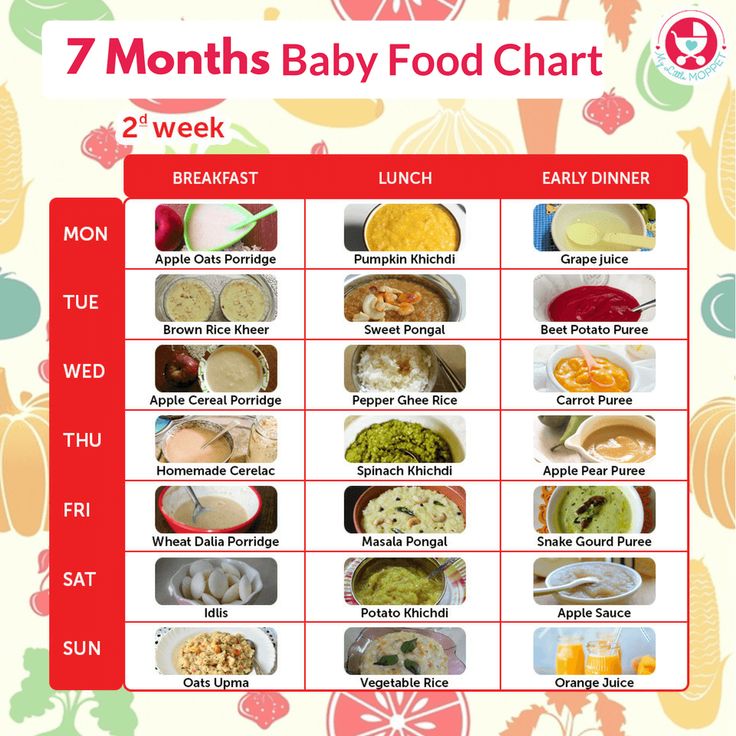 The ideal food created by nature for babies is mother's breast milk , with which he receives the necessary nutrients, vitamins, minerals and antibodies. If the mother does not have or does not have enough milk, then the child needs to introduce complementary foods in the form of artificial mixtures . But now this is no longer a problem, since the manufacturers of most artificial mixtures have brought the product to the proper level, which is able to fully replace breast milk. And regardless of what type of feeding the child chooses - breastfeeding or artificial formulas, the main complementary foods of the child should begin no earlier than 6 months according to the recommendations of WHO (World Health Organization) and UNICEF (UN Children's Fund), unless otherwise provided by medical recommendations as of child health. Early complementary foods (earlier than 6 months) are introduced on the recommendation of a pediatrician in accordance with medical indications, which is why it is also called pediatric .
The ideal food created by nature for babies is mother's breast milk , with which he receives the necessary nutrients, vitamins, minerals and antibodies. If the mother does not have or does not have enough milk, then the child needs to introduce complementary foods in the form of artificial mixtures . But now this is no longer a problem, since the manufacturers of most artificial mixtures have brought the product to the proper level, which is able to fully replace breast milk. And regardless of what type of feeding the child chooses - breastfeeding or artificial formulas, the main complementary foods of the child should begin no earlier than 6 months according to the recommendations of WHO (World Health Organization) and UNICEF (UN Children's Fund), unless otherwise provided by medical recommendations as of child health. Early complementary foods (earlier than 6 months) are introduced on the recommendation of a pediatrician in accordance with medical indications, which is why it is also called pediatric .
Starting from the age of 6 months, the need of the child's body for nutrients is no longer satisfied only by mother's milk and it is necessary to gradually introduce complementary foods . At this age, babies begin to show interest in adult food. Complementary foods should be introduced with small amounts of foods new to the baby and gradually increased as the baby gets older. nine0027
The child is introduced to new foods gradually, starting with very small portions. The new type of baby food includes nutritional supplements and complementary foods.
Food additives:
- fruit and berry juices;
- fruit purees;
- hen or quail egg yolk;
- cottage cheese
Complementary foods:
Complementary foods are a qualitatively new type of nutrition that meets the needs of a growing child's body in all food ingredients and accustoms to solid food. nine0004 This includes:
- vegetable purees;
- cereals;
- dairy products (kefir, yoghurt, biolact.
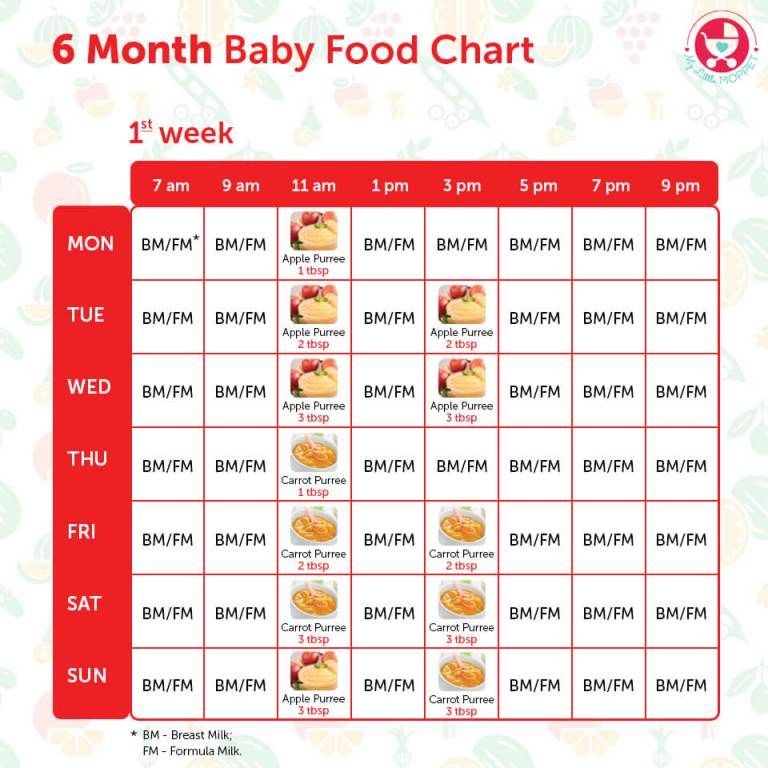 ..)
..)
Rules for the introduction of complementary foods:
- Complementary foods should be given before breastfeeding.
- Each type of complementary food should be introduced gradually, starting with a small amount (10-15 g) and increasing it to the desired volume within 7-10 days, completely replacing one breastfeed. nine0035
- You cannot enter two or more new dishes at the same time. You can switch to a new type of food only when the child gets used to the previous one.
- Complementary foods should be homogeneous in consistency and should not cause difficulty in swallowing.
- Complementary foods should only be given from a spoon.
- The number of feedings with the introduction of complementary foods is reduced to 5 times, then to 3 main and 2 snacks at the request of the child.
- The temperature of the dish should be equal to the temperature of the received mother's milk (approximately 37 C). nine0035
Supplementation scheme
Fruit and berry juice (introduced from 7-8 months)
Juice should start with drops.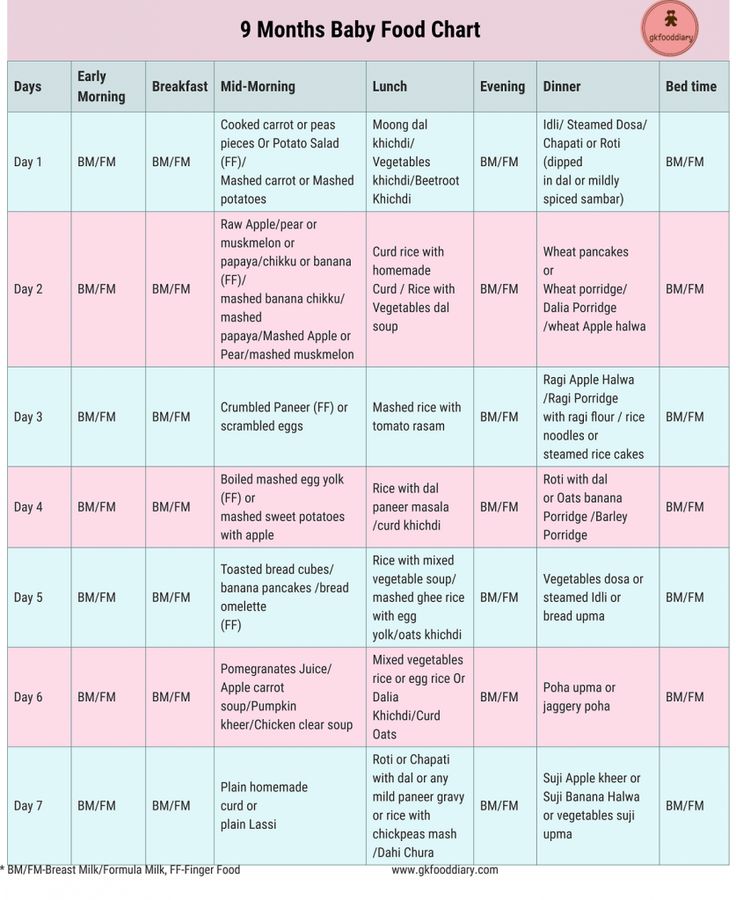 Within 7-10 days, bring to the required daily volume. Give after feeding or between feedings. It is advisable to use freshly made juices (must be diluted with water in a ratio of 1: 1), but juices in packages specifically designed for baby food are also suitable. The sequence of introduction of juices from berries, fruits and vegetables: apple, plum, apricot, peach, cherry, blackcurrant, pomegranate, cranberry, lemon, carrot, beet, cabbage. Citrus, tomato, raspberry, strawberry juices, juices from tropical fruits (mango, papaya, guava ...) - these juices should be given no earlier than 11-12 months. Grape juice is not recommended to include in the diet of a child at such an early age, as it can cause bloating. nine0003 Fruit and berry puree (introduced from 7 months)
Within 7-10 days, bring to the required daily volume. Give after feeding or between feedings. It is advisable to use freshly made juices (must be diluted with water in a ratio of 1: 1), but juices in packages specifically designed for baby food are also suitable. The sequence of introduction of juices from berries, fruits and vegetables: apple, plum, apricot, peach, cherry, blackcurrant, pomegranate, cranberry, lemon, carrot, beet, cabbage. Citrus, tomato, raspberry, strawberry juices, juices from tropical fruits (mango, papaya, guava ...) - these juices should be given no earlier than 11-12 months. Grape juice is not recommended to include in the diet of a child at such an early age, as it can cause bloating. nine0003 Fruit and berry puree (introduced from 7 months)
Puree should start with 0.5 teaspoon. Within 7-10 days, bring to the required daily volume. Give after feeding or between feedings. Both freshly prepared purees and fruit and berry preserves for baby food are used.
Yolk (introduced at 8-9 months)
You need to start with 1/4 of the yolk. You can give daily until the end of the year, 1/2 yolk at the beginning of feeding, after rubbing it with milk or with a complementary food dish. nine0003 Curd (introduced at 9-10 months)
Start with 5 grams (1 teaspoon). Gradually, within a month, bring up to 20 grams. By the end of the first year - 50-70 g. You need to give cottage cheese at the end of feeding.
Note:
- In order to maintain lactation after weaning, it is advisable to breastfeed the baby.
- Subject to good health, optimal indicators of physical and neuropsychic development, stable and sufficient lactation in the mother, her quality nutrition, the first complementary foods can be introduced no earlier than 6 months. nine0035
- When preparing complementary foods (dairy-free cereals, mashed potatoes), the optimal liquid for diluting them is breast milk or an adapted milk formula.

Five key food safety tips:
- Food should be clean.
- Keep raw and cooked food separate.
- Food must be prepared carefully.
- Keep food at a safe temperature. nine0035
- Clean water and food must be used for food preparation.
approximate weekly diet, daily menu for artificial and breastfeeding for an 8 month old baby
Published: 02/10/2021
Reading time: 3 min.
Number of reads: 88849
Author of the article: Ponomareva Yuliya Vladimirovna
Pediatrician, candidate of medical sciences, allergist-immunologist
An 8-month-old child is already an adult baby who knows a lot and even tries to defend his right to independence. The process of intensive growth and development continues - the baby is rapidly mastering new motor skills, improving in speech and cognitive activities.
The pace of growing up and high activity determine the clear requirements for the nutrition of the baby, which must quantitatively and qualitatively meet the needs of children at this stage of life.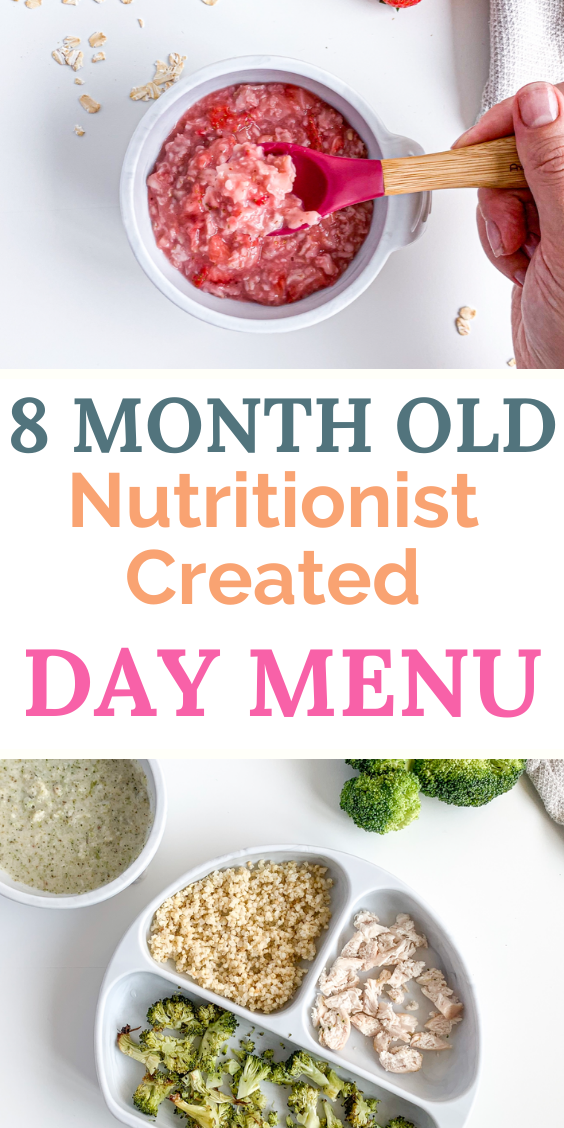 By the 8th month of life, the child's digestive tract is already quite mature. It is able to digest and assimilate the products of the main food groups. Let's look at the basic principles of compiling a baby's diet, and also develop a menu for 8 months, indicating an approximate list of dishes and a meal plan for a week. nine0027
By the 8th month of life, the child's digestive tract is already quite mature. It is able to digest and assimilate the products of the main food groups. Let's look at the basic principles of compiling a baby's diet, and also develop a menu for 8 months, indicating an approximate list of dishes and a meal plan for a week. nine0027
Contents: Hide
- General principles
- A must in the diet
- Sample menu for a week for 8 months
General principles Breast milk is no longer the basis of the diet, but continues to be a source of easily digestible and beneficial nutrients, and also protects the baby from many infectious diseases. If the baby is artificially fed, use an adapted mixture in the diet that suits him well and matches his age. In addition to breastfeeding, an 8-month-old baby's eating schedule includes 4-5 meals. Of these, three are basic (breakfast, lunch and dinner), two are additional (second breakfast and afternoon tea). The baby already withstands 3.
 5–4 hours between meals and at least 6 hours at night. The volume of each feeding is 170–200 ml and approximately 1000 ml/g per day. nine0027
5–4 hours between meals and at least 6 hours at night. The volume of each feeding is 170–200 ml and approximately 1000 ml/g per day. nine0027
A must in the diet
Your 8-month-old baby's daily menu should include the main food groups that guarantee the supply of vital nutrients - proteins, fats and carbohydrates. What products must be included in the menu at this age? Porridge is one of the first and most important complementary foods. It is rich in all the main nutrients, provides long-lasting satiety and has a pleasant taste. By the 8th month of life, babies digest and assimilate dishes from various cereals well, therefore, multi-component cereals with natural fruit or vegetable additives, dairy-free or based on specially prepared milk can be used in nutrition. nine0027
Vegetables and fruits do not have a high nutritional value, but are the main source of fiber. Therefore, they are also required in the daily menu. Meat complementary foods are a source of protein that is complete in terms of amino acid composition, and a baby should receive 60–80 grams of meat per day.